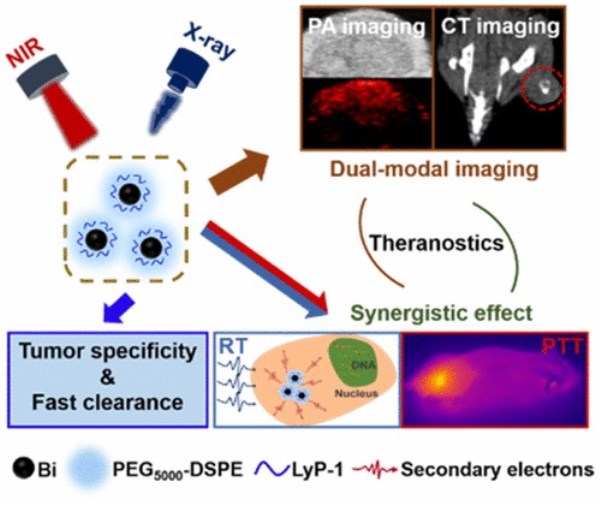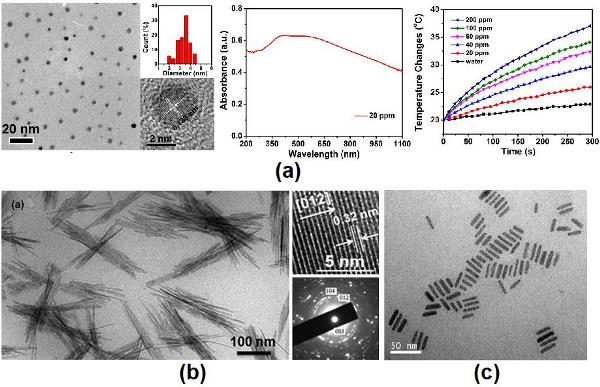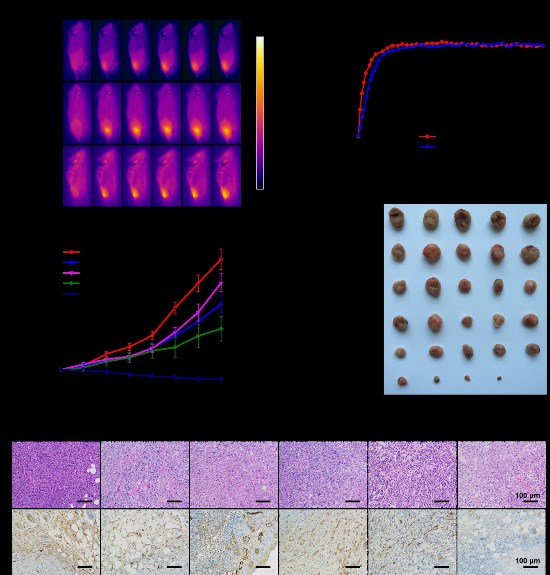Shanghai Jiaotong University made important progress in the field of multifunctional semi-metal nano-biomaterials
Recently, Li Wanwan's research team at the State Key Laboratory of Materials Science and Engineering & Metal Matrix Composites at Shanghai Jiaotong University has made important progress in the research and development of multifunctional semi-metal nano-biomaterials. The research results are based on "Ultrasmall Semimetal Nanoparticles of Bismuth. For Dual-Modal Computed Tomography/ Photoacoustic Imaging and Synergistic Thermoradiotherapy†is published in the famous journal ACS Nano (IF=13.334, DOI: 10.1021/acsnano.7b00476). The study reported a multi-functional nano-diagnosis reagent based on ultra-small metal hafnium nanoparticles, which not only achieved dual imaging (photoacoustic imaging (PA) and X-ray computed tomography (CT)) and tumor tissue The synergistic treatment of photothermal and radiotherapy demonstrated low biotoxicity and rapid tissue metabolism, indicating that the novel semimetal nanomaterials have broad application prospects in the diagnosis and treatment of tumors.

Figure 1 Surface-modified ultrasmall metal hafnium nanoparticles that target polypeptide molecules can achieve dual imaging of tumor tissue (photoacoustic imaging (PA) and X-ray computed tomography (CT)) and photothermal and radiotherapy of tumor tissue. Synergistic treatment.
In recent years, the rapid development of nanotechnology and biomedicine has promoted the application of multifunctional nano-biomaterials in the diagnosis and treatment of cancer, and in particular has promoted the development of cancer diagnosis and treatment integration. Multifunctional nanomaterials refer to a class of nanosystems that integrates multiple diagnostic or therapeutic functions. When materials are applied to living organisms, the intervention of corresponding external means can stimulate the various functions of the materials, thereby achieving the diagnosis or treatment of tumor tissues. the goal of. The traditional strategy is to composite nanomaterials with different functions into a whole nanometer system, in which multiple functions are realized by different components of nanomaterials. Since large-size nanomaterials are easily enriched and remain in the vital organs of organisms (especially liver, spleen, etc.) for a long time, resulting in biological toxicity, the design and preparation of multifunctional nanomaterials that can be rapidly metabolized have gradually become researched. Hot spot. Radiation therapy and photothermal therapy are important methods for cancer therapy. The former uses radiotherapy sensitizers to increase the content of high-energy X-rays in tumor tissue to destroy the tissue structure and thus kill cancer cells. The latter uses light-heat materials to irradiate near-infrared light. The thermal effect on the tumor tissue is achieved to kill the cancer cells. By combining the advantages of nanotechnology with the needs of radiosensitizers and photothermal materials, a series of new nanobiomaterials are gradually being prepared and applied in the diagnosis and treatment of tumors.
Semi-metals (such as tantalum, niobium, etc.) are a type of material that is interposed between a metal and a semiconductor. When the particle size of such a material is reduced to the nanometer scale, a unique material property is exhibited due to the quantum size effect. Among them, due to the high atomic number, low effective carrier mass, long Fermi wavelength, and small energy band overlap of germanium germanium, germanium nanomaterials such as germanium sulfide and germanium selenide are widely used in oncological radiation therapy. Photothermal therapy research and tumor imaging. However, although many studies have shown that the treatment and contrast effects of binary or ternary terpenoid nanomaterials are derived from niobium, no work has yet been reported on whether pure niobium nanomaterials have the effects of tumor treatment and imaging and whether they can be applied. In animal experiments. At the same time, these studies have paid more attention to biological results and have neglected to study this type of material from the point of view of the helium element being semimetal.

Figure 2 (a) Ultra-small semi-metallic hafnium nanoparticles and their photothermal properties; (b) Semi-metallic hafnium nanorod bundles; (c) Semi-metallic compounds sulphur-copper nanorods.
In recent years, the research team has been mainly engaged in the preparation and application of semi-metals and their compounds, based on pre-metal hafnium nanoparticles (Biomaterials, 2015, 45: 18-26) and semi-metallic compounds thallium copper nanorods (Biomaterials, 2017, 112 : 164-175) The research results of the preparation of ultra-small metal hafnium nanomaterials with a size of 3.6 nm were developed by designing a new synthesis method, and a small molecule polypeptide that specifically binds to the tumor surface p32 protein was modified on the surface of the material (CGNKRTRGC, LyP). -1) to increase the enrichment of nanomaterials in tumors. The results show that the semi-metal tellurium nanomaterial is a new type of multifunctional nanomaterial with excellent photothermal conversion efficiency (1064 nm, 32.2%) and radiotherapy sensitivity (SER10=1.248), which can be used in the near infrared two. Area laser (1064 nm) photothermal therapy and low dose radiation therapy. The enriched content of the polypeptide-modified metallohalide nanomaterials in cells as well as in the organs of mice were all increased, and there was no obvious cytotoxicity and long-term biological toxicity. The study also found that the semi-metallic hafnium nanomaterials exhibited excellent dual-mode photoacoustic and CT imaging capabilities, as well as high-efficiency mouse breast cancer radiotherapy and photothermal co-treatment capabilities, confirming the versatility of the semimetal niobium nanomaterials. The ability of ultra-small metal hafnium nanomaterials to rapidly metabolize from mice through organs such as the kidneys suggests that organisms will not cause possible toxic side effects due to nanomaterials after intervention of diagnostic and therapeutic means. These work not only confirm the value of nanomaterial itself in biomedical applications, but also further prove the semi-metallic element as a new multifunctional nanomaterial with excellent properties, providing new options for the research and application of nanometer diagnostic reagents.

Fig. 3 Photothermal/radiotherapy synergistic treatment of mouse mammary tumors with super-small metallohalide nanoparticles that are surface modified targeting polypeptide molecules.
The first author of the thesis was Dr. Yu Xujiang. This work was done in collaboration with Associate Professor Yang Kai of the School of Radiation Medicine and Protection of the School of Medicine of Soochow University. He also received the National Institutes of Health (NIH) Chen Xiaoyuan. In addition, the smooth development of the research also benefited from the support of the National Natural Science Foundation of China and the Shanghai Municipal Science and Technology Commission.
Zhuzhou Zhirong Advanced Material Co., Ltd , https://www.zrcarbide.com
